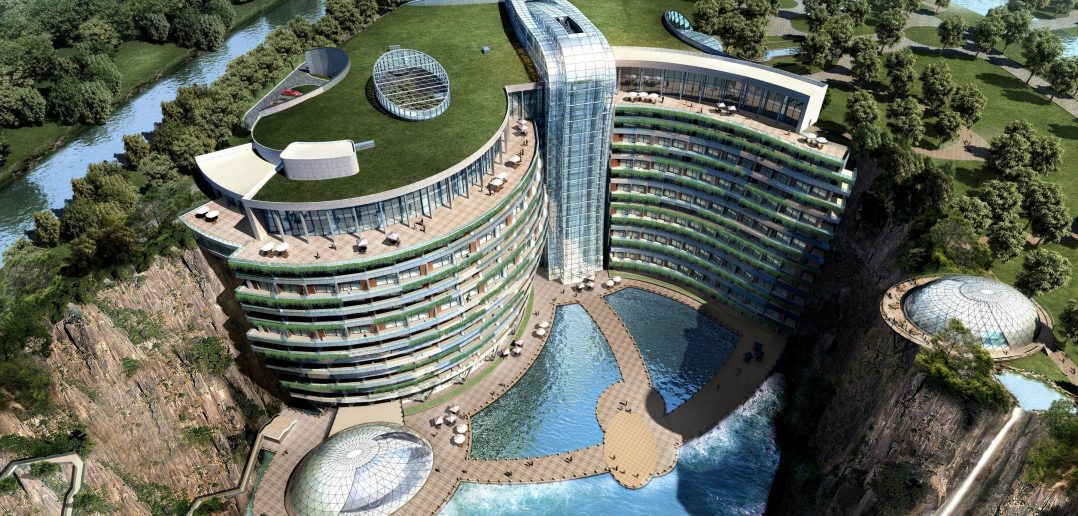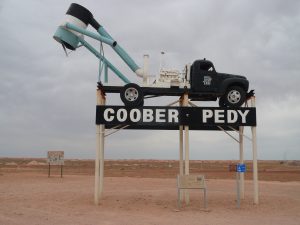In the future more of us will live in cities. In fact, the UN estimates an extra two and a half billion people will live in urban centres by 2050. Where will all these extra people live? Our in-house psychic thinks the solution lies beneath our feet.
Old Moore predicts that humans will begin to live underground on a large scale in the future. Many cities already make use of their subterranean space; however, Old Moore thinks the future of underground building will see us go deeper, with underground skyscrapers providing living and office space in megacities around the world.
The idea of building underground skyscrapers seems like something straight out of a movie – remember District 13 in The Hunger Games: Catching Fire? Viewed through the lens of today’s world, it seems wildly unrealistic. For a start, there’s the time and expense involved in building huge subterranean structures; there’s also the fact that the thought of living underground isn’t exactly appealing. In the future, however, subterranean life will be more tempting than it is now, and new technology will address the practicalities.
Temperature Extremes
As time goes by planet earth will experience greater extremes of heat and cold, thanks to climate change. Think about the heatwaves experienced across the Northern hemisphere in the last two years; last summer’s heatwave even made it as far as our own little island. Underground life would shelter us from these extremes because soil can store heat and protect against temperature fluctuations. And we wouldn’t have to worry about the high cost or environmental impact of heating and air-conditioning systems.
There’s already a community of people who live underground for exactly this reason – more than half of people in the remote Australian mining town of Coober Pedy live in homes dug out of caves in the hillsides. While temperatures outside often reach 40 degrees, inside it remains around 20 degrees. Even the local bar, hotel, casino and church have been built underground!
- Coober Pedy: population 2,500
- Underground living offers a refuge from 40 degree heat
A Port in the Storm
Tomorrow’s world will also see us experience more disruptive weather events. We have begun to witness these already, and Old Moore thinks they will grow both in number and in effect. Imagine the convenience of living and working in an underground skyscraper during a huge snowstorm or hurricane – no need to struggle through the city streets to go to work or get the shopping in, just hop into the lift and off you go!
Montreal’s Underground City gives some idea of the potential advantages to living underground. Thirty-three kilometres of pedestrian tunnels, used by half a million people daily, connect businesses, restaurants, shops, hotels and cultural spaces. Residents and tourists can get about no matter what the Canadian weather brings.
Growing Populations
And then there is the issue of rising urban populations. Many cities are limited in their potential for growth – Mexico City is a good example. Nine million people live there, with another twelve million living in the surrounding metropolis of Greater Mexico City. Development is severely hampered by a ban on the demolition of old buildings in the city’s UNESCO listed historical district. Building up is not an option for city planners either – there’s a height restriction of eight stories due to the risk of earthquake damage.
Clearly there is a need for an imaginative and innovative planning solution. Well, it may surprise you to learn that plans already exist for an underground skyscraper in Mexico City. A firm of architects called Bunker Arquitectura have put forward the idea of an ‘Earthscraper’, a 65-floor inverted pyramid descending 300 metres into the ground. The building will have a glass roof and a central core so that natural light can penetrate even to the deeper floors. It could potentially house 100,000 people.


- Zócalo, Mexico City’s central square, as it looks today
- An artist’s impression of the Earthscraper from above
Amazingly, the Earthscraper is not the only proposal of its kind. A 2010 entry to the Evolo Skyscraper Competition proposed a similar structure on the site of a former Arizona mine. The project, entitled ‘Above Below’, would restore the decimated landscape by filling in a 300-acre-wide crater. Apart from skylights on the desert floor, it would be almost invisible when viewed from above. The 270-metre deep building, with living, working and green spaces, would be completely self-sustainable in terms of power supply, climate control and water recycling. It would even have a rail system linking it to the nearest city, and terraces for underground farms on its upper levels.
Can It Be Done?
Imagining such a future is all very well but is it really feasible? How would these structures be built and what problems would need to be overcome? One of the biggest issues with underground building is that beyond a certain depth, it’s necessary to tunnel into bedrock.
The depth of bedrock varies greatly – it can lie just under the surface or hundreds of metres below. As you can probably guess, tunneling into bedrock would be expensive and time-consuming. Supporting the building against soil pressure would be another major challenge – the frame and walls would need to be massive. However, Old Moore thinks that new technologies will enable us to overcome these problems.
A recently opened Chinese hotel has already addressed some of these difficulties. Built in an abandoned quarry by British firm Atkins, the Intercontinental Shanghai Wonderland required innovative engineering solutions. Sixteen of the eighteen floors are underground, with the two lowest floors being submerged in an aquarium.


The recently opened Intercontinental Shanghai Wonderland Hotel
Located close to the Sheshan Mountains and National Forest Park, the hotel’s design minimizes the environmental impact on the surrounding landscape. There are even plans to generate geothermal and solar energy enabling the hotel to supply much of its own power. You can discover more about this amazing hotel (and maybe even book a room) here.
So, at present underground skyscrapers remain a costly and risky experiment – but we’re already taking baby steps towards them. The big question is whether we’re ready to live and work underground. Perhaps not yet, but with an uncertain future ahead, who knows? One of our great advantages as a species is our ability to adapt. When circumstances demand it, we’ll do whatever it takes to survive and flourish – just ask the people of Coober Pedy.









